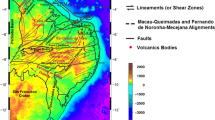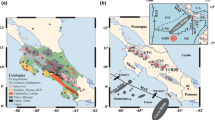Abstract
A 3D shear wave velocity model of the subsurface of Popocatépetl volcano was obtained using ambient noise tomography, employing the principal cross-terms of the empirical Green’s function. Daily cross-correlation waveforms were computed from the data recorded by four seismic broadband stations in 2012. Dispersion curves were estimated from the stack of anti-causal and causal parts for the three ground motion components. In the period ranging between 0.5 and 7 s, the radial component provided the most well-defined group velocity dispersion curves for Rayleigh waves. Dispersion curves for long paths (> 9.5 km) suggested the presence of a layered structure with group velocity values ranging from 0.5 to 3.0 km/s. Dispersion curves for short paths (< 7 km) and close to the volcano showed values similar to those for long paths but with a velocity inversion occurring between 3- and 5-s periods. Despite the scarce ray-path coverage, a tomography inversion provided the means to image an S-wave velocity anomaly (2.5–3.0 km/s) in the northern part of the crater at depths not larger than 6 km. The volcano-tectonic seismicity during 2012–2013 was found to be concentrated in the southern segment of this anomaly, which seems to mark a boundary between a solidified body (possibly a product of ancient volcanic craters) and the softer material.












Similar content being viewed by others
References
Arámbula-Mendoza R, Valdés-González C, Martínez-Bringas A (2010) Temporal and spatial variation of the stress state of Popocatépetl Volcano, Mexico. J Volcanol Geotherm Res 196(3-4):156–168. https://doi.org/10.1016/j.jvolgeores.2010.07.007
Benediktsdóttir Á, Gudmundsson Ó, Brandsdóttir B, Tryggvason A (2017) Ambient noise tomography of Eyjafjallajökull volcano, Iceland. J Volcanol Geotherm Res 347:250–263. https://doi.org/10.1016/j.jvolgeores.2017.09.017
Bensen GD, Ritzwoller MH, Barmin MP, Levshin AL, Lin F, Moschetti MP, Shapiro NM, Yang Y (2007) Processing seismic ambient noise data to obtain reliable broad-band surface wave dispersion measurements. Geophys J Int 169(3):1239–1260. https://doi.org/10.1111/j.1365-246X.2007.03374.x
Berger P, Got JL, González CV, Monteiller V (2011) Seismic tomography at Popocatépetl volcano, Mexico. J Volcanol Geotherm Res 200(3-4):234–244. https://doi.org/10.1016/j.jvolgeores.2010.12.016
Brenguier F, Shapiro NM, Campillo M, Nercessian A, Ferrazzini V (2007) 3-D surface wave tomography of the Piton de la Fournaise volcano using seismic noise correlations. Geophys Res Lett 34(2). https://doi.org/10.1029/2006GL028586
Brenguier F, Clarke D, Aoki Y, Shapiro NM, Campillo M, Ferrazzini V (2011) Monitoring volcanoes using seismic noise correlations. Compt Rendus Geosci 343(8-9):633–638. https://doi.org/10.1016/j.crte.2010.12.010
Brenguier F, Rivet D, Obermann A, Nakata N, Boué P, Lecocq T, Campillo M, Shapiro N (2016) 4-D noise-based seismology at volcanoes: ongoing efforts and perspectives. J Volcanol Geotherm Res 321:182–195. https://doi.org/10.1016/j.jvolgeores.2016.04.036
Campillo M (2003) Long-range correlations in the diffuse seismic coda. Science 299(5606):547–549. https://doi.org/10.1126/science.1078551
Campillo M (2006) Phase and correlation in ‘random’ seismic fields and the reconstruction of the Green function. Pure Appl Geophys 163(2-3):475–502. https://doi.org/10.1007/s00024-005-0032-8
Chávez-García FJ, Luzón F (2005) On the correlation of seismic microtremors. J Geophys Res Solid Earth 110(B11). https://doi.org/10.1029/2005JB003671
Chen K-X, Gung Y, Kuo B-Y, Huang T-Y (2018) Crustal magmatism and deformation fabrics in northeast Japan revealed by ambient noise tomography. J Geophys Res Solid Earth 123:8891–8906. https://doi.org/10.1029/2017JB015209
Chiao L, Liang W (2003) Multiresolution parameterization for geophysical inverse problems. Geophys 68(1):199–209. https://doi.org/10.1190/1.1543207
Cruz-Atienza VM, Pacheco JF, Singh SK, Shapiro NM, Valdés C, Iglesias A (2001) Size of Popocatepetl volcano explosions (1997-2001) from waveform inversion. Geophys Res Lett 28(21):4027–4030. https://doi.org/10.1029/2001GL013207
De Barros L, Pedersen HA, Métaxian JP, Valdés-Gonzalez C, Lesage P (2008) Crustal structure below Popocatépetl volcano (Mexico) from analysis of Rayleigh waves. J Volcanol Geotherm Res 170(1-2):5–11. https://doi.org/10.1016/j.jvolgeores.2007.09.001
De Cserna Z, De la Fuente-Duch M, Palacios-Nieto M, Triay L, Mitre-Salazar LM, Mota-Palomino R (1988) Estructura geológica, gravimetría, sismicidad y relaciones neotectónicas regionales de la Cuenca de México. Boletín del Inst Geol 104(71)
De la Cruz-Reyna S, Tilling RI (2008) Scientific and public responses to the ongoing volcanic crisis at Popocatépetl Volcano, Mexico: importance of an effective hazards-warning system. J Volcanol Geotherm Res 170(1-2):121–134. https://doi.org/10.1016/j.jvolgeores.2007.09.002
De Plaen RS, Lecocq T, Caudron C, Ferrazzini V, Francis O (2016) Single-station monitoring of volcanoes using seismic ambient noise. Geophys Res Lett 43(16):8511–8518. https://doi.org/10.1002/2016GL070078
Donaldson C, Caudron C, Green RG, Thelen WA, White RS (2017) Relative seismic velocity variations correlate with deformation at Kīlauea volcano. Sci Adv 3(6):e1700219. https://doi.org/10.1126/sciadv.1700219
Espinasa-Pereña R, Martín-Del Pozzo AL (2006) Morphostratigraphic evolution of Popocatépetl volcano, México. In Spec Neogene-Quaternary Cont Margin Volcanism A Perspect from México, Geological Society of America 402:115–137.
Fang H, Zhang H (2014) Wavelet-based double-difference seismic tomography with sparsity regularization. Geophys J Int 199(2):944–955. https://doi.org/10.1093/gji/ggu305
Fang H, Yao H, Zhang H, Huang YC, Van Der Hilst RD (2015) Direct inversion of surface wave dispersion for three-dimensional shallow crustal structure based on ray tracing: methodology and application. Geophys J Int 201(3):1251–1263. https://doi.org/10.1093/gji/ggv080
Ferrari L, Garduno VH, Pasquare G, Tibaldi A (1994) Volcanic and tectonic evolution of central Mexico: oligocene to present. Geofis Int 33(1):91–105
Gao H, Shen Y (2015) A preliminary full-wave ambient-noise tomography model spanning from the Juan de Fuca and Gorda spreading centers to the Cascadia volcanic arc. Seismol Res Lett 86(5):1253–1260. https://doi.org/10.1785/0220150103
Guidarelli M, Aoudia A (2016) Ambient noise tomography of the Cameroon Volcanic Line and Northern Congo craton: new constraints on the structure of the lithosphere. Geophys J Int 204(3):1756–1765. https://doi.org/10.1093/gji/ggv561
Helffrich G, Wookey J, Bastow I (2013) The seismic analysis code: a primer and user’s guide. Cambridge University Press.
Herrmann RB (2013) Computer programs in seismology: an evolving tool for instruction and research. Seismol Res Lett 84(6):1081–1088. https://doi.org/10.1785/0220110096
Jeddi Z, Gudmundsson O, Tryggvason A (2017) Ambient-noise tomography of Katla volcano, south Iceland. J Volcanol Geotherm Res 347:264–277. https://doi.org/10.1016/j.jvolgeores.2017.09.019
Kuznetsov P, Koulakov IY (2014) The three-dimensional structure beneath the Popocatépetl volcano (Mexico) based on local earthquake seismic tomography. J Volcanol Geotherm Res 276:10–21. https://doi.org/10.1016/j.jvolgeores.2014.02.017
Lobkis OI, Weaver RL (2001) On the emergence of the Green’s function in the correlations of a diffuse field. J Acoust Soc Am 110(6):3011–3017. https://doi.org/10.1121/1.1417528
Macías JL (2007) Geology and eruptive history of some active volcanoes of México. In Spec. Pap. Geol. México Celebr. Centen. Geol Soc, Geological Society of America 422:183–232.
Martin-Del Pozzo AL, Cifuentes-Nava G, Cabral-Cano E, Sánchez-Rubio G, Reyes M, Martínez-Bringas A, Garcia E, Arango-Galvan C (2002) Volcanomagnetic signals during the recent Popocatépetl (México) eruptions and their relation to eruptive activity. J Volcanol Geotherm Res 113(3-4):415–428. https://doi.org/10.1016/S0377-0273(01)00275-X
Pasquare G, Vezzoli L, Zanchi A (1986) Morphological and structural model of Mexican Volcanic Belt. Geofis Int 26(2)
Quezada-Reyes A, Lesage P, Valdés-González C, Perrier L (2013) An analysis of the seismic activity of Popocatepetl volcano, Mexico, associated with the eruptive period of December 2002 to February 2003: looking for precursors. Geol Soc Am Spec Pap 498:89–106
Rawlinson N, Kennett BL (2004) Rapid estimation of relative and absolute delay times across a network by adaptive stacking. Geophys J Int 157(1):332–340. https://doi.org/10.1111/j.1365-246X.2004.02188.x
Rawlinson N, Sambridge M (2004) Wave front evolution in strongly heterogeneous layered media using the fast-marching method. Geophys J Int 156(3):631–647. https://doi.org/10.1111/j.1365-246X.2004.02153.x
Reyes-Pimentel TA (2021) Estudio de la actividad sismica del Volcan Popocatépetl en el periodo 2012-2013. Msc (in review), Posgrado en Ciencias de la Tierra, National Autonomus University of Mexico.
Sabra KG, Gerstoft P, Roux P, Kuperman WA, Fehler MC (2005) Surface wave tomography from microseisms in Southern California. Geophys Res Lett 32(14). https://doi.org/10.1029/2005GL023155
Schimmel M, Stutzmann E, Gallart J (2011) Using instantaneous phase coherence for signal extraction from ambient noise data at a local to a global scale. Geophys J Int 184(1):494–506. https://doi.org/10.1111/j.1365-246X.2010.04861.x
Schimmel M, Stutzmann E, Ventosa S (2017) Measuring group velocity in seismic noise correlation studies based on phase coherence and resampling strategies. IEEE Trans Geosci Remote Sens 55(4):1928–1935. https://doi.org/10.1109/TGRS.2016.2631445
Shapiro NM, Campillo M, Stehly L, Ritzwoller MH (2005) High-resolution surface-wave tomography from ambient seismic noise. Science 307(5715):1615–1618. https://doi.org/10.1126/science.1108339
Snieder R, Miyazawa M, Slob E, Vasconcelos I, Wapenaar K (2009) A comparison of strategies for seismic interferometry. Surv Geophys 30(4-5):503–523. https://doi.org/10.1007/s10712-009-9069-z
Spica Z, Perton M, Legrand D (2017) Anatomy of the Colima volcano magmatic system, Mexico. Earth Planet Sci Lett 459:1–13. https://doi.org/10.1016/j.epsl.2016.11.010
Straub SM, Martin-Del Pozzo AL (2001) The significance of phenocryst diversity in tephra from recent eruptions at Popocatepetl volcano (central Mexico). Contrib Mineral Petrol 140(4):487–510. https://doi.org/10.1007/PL00007675
Taira TA, Brenguier F (2016) Response of hydrothermal system to stress transients at Lassen Volcanic Center, California, inferred from seismic interferometry with ambient noise. Earth Planets and Space 68(1):1–13. https://doi.org/10.1186/s40623-016-0538-6
UNAM Seismology Group (2013) Ometepec-Pinotepa Nacional, Mexico Earthquake of 20 March 2012 (Mw 7.5): A preliminary report. Geofis Int 52(2):173–196
Wessel P, Smith W, Eickschen S, Henstock T, Horner-Johnson B (2017) The Generic Mapping Tools.
Acknowledgements
CENAPRED kindly provided the seismic records of the Popocatépetl stations. This study was possible thanks to the support by UNAM-DGAPA-PAPIIT Programs: IN117217 and IN117119. Part of the research is the result of a bilateral collaboration project between Universidad Nacional Autónoma de México and Indian Institute of Science, supported by Consejo Nacional de Ciencia y Tecnología, Mexico, and Department of Science and Technology, India, project 266055, approved in the call C0013-2015-03. We thank Hongjian Fang for his comments on the use of the DSurfTomo tomography software (https://github.com/HongjianFang/DSurfTomo, last accessed February 28, 2019). We would like to thank Dr. F. J. Chávez-García and anonymous reviewers for their thoughtful comments and recommendations to improve our manuscript.
Data availability of data and material
Material is available from the authors upon request. Datasets related to this article can be downloaded from https://www.gob.mx/cenapred.
Code availability
Data processing was done using open-source codes (Herrmann 2013; Rawlinson and Kennett 2004; Schimmel et al. 2011; Helffrich et al. 2013; Wessel et al. 2017; Fang and Zhang 2014). Smaller code segments were written by the authors.
Funding
This study was funded by the UNAM-DGAPA-PAPIIT Programs IN117217 and IN117119, and partially supported by project 266055, C0013-2015-03 CONACYT-DST.
Author information
Authors and Affiliations
Contributions
M. C. S.: conceptualization, methodology, writing—original draft preparation. T. A. R. P.: data curation, investigation, resources. J. T.: visualization, writing–review. T. N.: visualization, writing—reviewing and editing.
Corresponding author
Ethics declarations
Competing interests
The authors declare no competing interests.
Additional information
Publisher’s note
Springer Nature remains neutral with regard to jurisdictional claims in published maps and institutional affiliations.
Article highlights
• A 3D model of the internal structure of the Popocatépetl volcano has been produced using ambient seismic noise analysis.
• The presence of a high-velocity zone, a solidified body produced by ancient volcanic episodes, has been reverified.
• Explained the clustering of volcano tectonic earthquakes along faults that limit significant velocity anomaly.
Rights and permissions
About this article
Cite this article
Cárdenas-Soto, M., Reyes-Pimentel, T.A., Tago, J. et al. Ambient noise tomography of the Popocatépetl volcano using the principal Green tensor components . J Seismol 25, 1089–1102 (2021). https://doi.org/10.1007/s10950-021-10021-4
Received:
Accepted:
Published:
Issue Date:
DOI: https://doi.org/10.1007/s10950-021-10021-4




